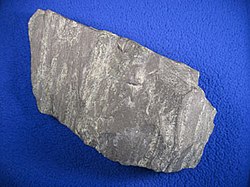| Sedimentary iron formation rock | |
 | |
| Composition | |
|---|---|
| Primary | Magnetite, hematite and chert |
| Secondary | Siderite, greenalite, minnesotaite and stilpnomelane |
Taconite (/ˈtækənaɪt/) is a variety of banded iron formation, an iron-bearing (over 15% iron) sedimentary rock, in which the iron minerals are interlayered with quartz, chert, or carbonate. The name taconyte was coined by Horace Vaughn Winchell (1865–1923) – son of Newton Horace Winchell, the Minnesota state geologist – during their pioneering investigations of the Precambrian Biwabik Iron Formation of northeastern Minnesota. He believed the sedimentary rock sequence hosting the iron-formation was correlative with the Taconic orogeny of New England, and referred to the unfamiliar and as-yet-unnamed iron-bearing rock as the 'taconic rock' or taconyte.[1]
Following development of high grade direct shipping iron ore deposits on the Mesabi Range, containing up to 65% iron and as little as 1.25% silica, miners termed the unaltered iron-formation wall rock taconite. The iron content of taconite is generally 30% to 35%, and the silica content generally around 45%. Iron in taconite is commonly present as magnetite, iron silicates, and iron-bearing carbonates, and locally martite (hematite) formed by oxidation of magnetite. Horizons containing magnetite as the dominant mineral have been extensively mined since 1955 to produce iron ore pellets; the term 'taconite' has consequently been colloquially adapted to describe the magnetite iron-formation ores (taconite iron ore), the mining, milling, magnetic separation, and agglomerating process (taconite process), and the product iron ore pellets (taconite pellets).
- ^ Winchell, Horace V. (1891) "The Mesabi iron range," in: Winchell, Newton H., ed., The Geological and Natural History Survey of Minnesota (Minneapolis, Minnesota, USA: Harrison & Smith), vol. 20, p. 124. From p. 124: "This rock is widely spread over the whole length of the Mesabi, and being different from anything found elsewhere and peculiar to this horizon of the Taconic, has been called taconyte by the writer."